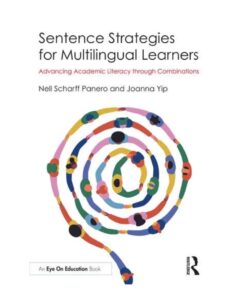Sentence Strategies for Multilingual Learners: Advancing Academic Literacy through Combinations
By Nell Scharff Panero and Joanna Yip
(Routledge/Eye On Education, 2024 – Learn more)
Reviewed by Melinda Stewart
 Let me start by saying that I have comments written on every page of Sentence Strategies for Multilingual Learners: Advancing Academic Literacy through Combination, and since finishing it, I have quoted from the book (more than once) while conversing with other educators.
Let me start by saying that I have comments written on every page of Sentence Strategies for Multilingual Learners: Advancing Academic Literacy through Combination, and since finishing it, I have quoted from the book (more than once) while conversing with other educators.
Nell Scharff Panero and Joanna Yip offer us a robust toolkit designed to empower educators with effective strategies for supporting multilingual learners as they navigate the intricacies of language and literacy acquisition through content.
 The book begins by establishing a solid theoretical foundation, outlining the unique linguistic challenges faced by many multilingual students and the importance of explicitly teaching sentence-level strategies.
The book begins by establishing a solid theoretical foundation, outlining the unique linguistic challenges faced by many multilingual students and the importance of explicitly teaching sentence-level strategies.
Panero and Yip draw upon both research and personal experience to advocate for a systematic approach that scaffolds learners’ understanding and application of sentence structures across different genres and academic contexts. Throughout the book they show how all teachers can share the responsibility for improving outcomes for multilingual learners while integrating language and content instruction to develop critical thinking.
A Comprehensive, Practical Guide
One of the standout features of Sentence Strategies for Multilingual Learners: Advancing Academic Literacy through Combinations is its practicality. The authors introduce us to Combinations and provide a comprehensive range of instructional techniques, exercises, and examples that educators can immediately implement in their classrooms. From sentence combining activities to sentence manipulation exercises, each strategy is meticulously explained and accompanied by insights into how it supports language development and academic literacy (hence the reason I have quoted the book on more than one occasion – it makes sense!).
Readers learn how to use Combinations’ seven strategies as part of a formative assessment system to better understand the assets and needs of the learners in their classroom. And Panero and Yip support their advocacy for systematic transformation as they share how to take the learning beyond the individual classroom. They offer suggestions on ways educators can work together, as well as how administrators and other supportive positions can collaborate to identify needs and improve the learning trajectory of all students.
Metacognitive and Culturally Responsive
I appreciated the book’s emphasis on metacognitive strategies and explicit instruction, but reflection and transfer are not just for the educator. Targeted, scaffolded instructions can greatly impact multilingual learners’ academic success. Panero and Yip continually highlight the importance of helping students understand not only how sentences work structurally but also how to strategically use sentence variations to enhance clarity, coherence and rhetorical effectiveness in their writing.
Sentence Strategies for Multilingual Learners addresses the socio-cultural aspects of language learning, advocating for culturally responsive teaching practices that validate and build upon learners’ linguistic backgrounds and experiences. The authors’ approach underscores the importance of creating inclusive learning environments where all students feel empowered to engage with and master academic, contextual language. Their approach emphasizes the value of structured support and strategic instruction in fostering language proficiency and academic achievement.
An Invaluable Resource!
Sentence Strategies for Multilingual Learners: Advancing Academic Literacy through Combinations is an invaluable resource for educators committed to supporting multilingual learners in developing proficiency in academic language and literacy.
Nell Scharff Panero and Joanna Yip’s expertise, coupled with their practical approach and rich array of instructional strategies and accompanying examples, makes this book essential reading for educators seeking to find access points into their content for multilingual students who do not yet have the foundational English language skills needed for success in academic writing and beyond.
I highly recommend this book to language educators, literacy specialists and instructional coaches looking to enhance their instructional repertoire and effectively support multilingual learners on their educational journey.
Melinda Stewart has been an educator for 30 years. She has an MA in Teaching, Education and Learning and has done graduate work in the areas of English as a Second Language, Reading, Spanish, and most recently English Language Arts. She is currently working as a Spanish teacher and ELM coach at Fairmont Junior Senior High School. Melinda is an MEA and AFT professional development facilitator and trainer who has a deep passion for learning and equity.


